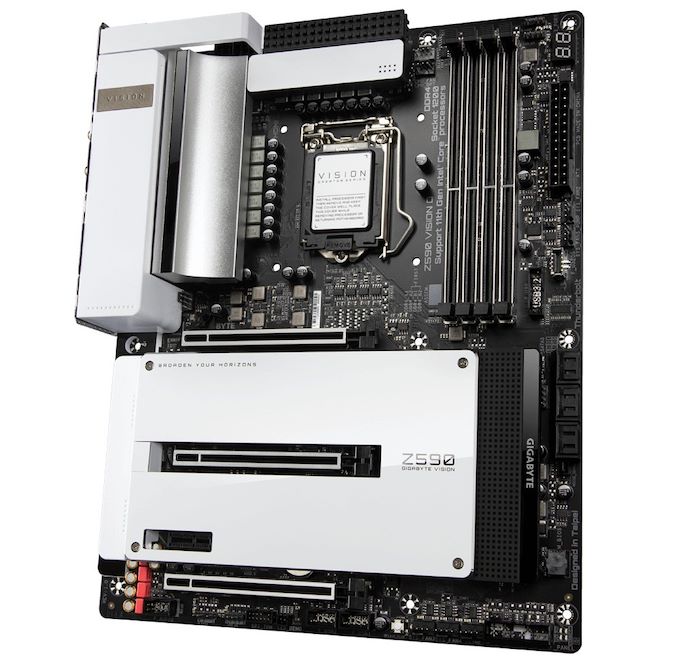The Intel Z590 Motherboard Overview: 50+ Motherboards Detailed
by Gavin Bonshor on January 19, 2021 10:15 AM ESTGIGABYTE Z590 Vision D
The GIGABYTE Z590 Vision D is the top tier model in its line up for creators, with exquisite silver and black contrasting design. Like GIGABYTE's Designare models, which focus on premium controller sets utilized by creators and designers, the Z590 Vision D includes Thunderbolt 4 Type-C, three PCIe M.2 slots, dual 2.5 GbE, and Wi-Fi 6E networking. In the top-right hand corner is a two-digit LED debugger, with a wave of PCIe slot armor that matches the design of the rear panel cover and the power delivery heatsink covers.
Looking towards the center of the board sits the PCIe area, with three full-length PCIe slots operating at PCIe 4.0 x16, and x8/x8. The third slot is locked at PCIe 3.0 x4, with a single PCIe 3.0 x1 slot. The GIGABYTE offers three M.2 slots, with one PCIe 4.0 x4 and two PCIe 3.0/SATA, with six SATA ports for conventional drives with support for RAID 0, 1, 5, and 10 arrays. As it stands, GIGABYTE hasn't given us the QVL list for memory support, so it's listed at Intel's default DDR4-3200 spec, although the four memory slots can accommodate up to 128 GB. Like the Z590 Vision G, the GIGABYTE Z590 Vision D includes a USB 3.2 G2x2 Type-C internal header.
The GIGABYTE Z590 Vision G has a premium rear panel, with two Thunderbolt 4 Type-C ports supported with a DisplayPort input and two USB 3.2 G2 Type-A and four USB 3.2 G1 Type-A ports. Realtek's latest ALC4080 HD audio codec makes an appearance and drives the five color-coded 3.5 mm audio jack and S/PDIF optical output. In contrast, an HDMI video output offers users support for Intel's HD integrated graphics. Finishing off the rear panel is a pair of Intel I225-V 2.5 GbE controllers, with Intel's latest AX210 Wi-Fi 6E CNVi, which also includes support for BT 5.2 devices.
At the time of writing, GIGABYTE hasn't shared any details on its Z590 models' pricing.












88 Comments
View All Comments
Oxford Guy - Tuesday, January 19, 2021 - link
You’ll never be able to block all the spyware with a firewall. Windows is just one component of it. Don’t forget things like stealth CPUs that are built into the CPU, like the little friend on Lando’s shoulder. Etc.lmcd - Tuesday, January 19, 2021 - link
What, the tinfoil hat isn't enough anymore? The "spyware" is just as present on any Windows era.If you want to disable built in telemetry, pay for pro and disable it in the registry. It's not hard if you're really that into privacy.
Spunjji - Wednesday, January 20, 2021 - link
@lmcd - but that would require *effort* - why waste that effort on customising a modern OS, when he could expend more effort cobbling together a barely-working platform on a 12-year-old one? 😂Makaveli - Wednesday, January 20, 2021 - link
lol all I saw in my head reading those post are "old man yells at clouds"Oxford Guy - Friday, January 22, 2021 - link
That’s due to the fact that the old man has just as much chance of getting the spyware out of Windows and CPUs (and the rest) as you lot have a chance of saying something relevant.Oxford Guy - Friday, January 22, 2021 - link
Call us when the shuttle lands, Pauline.Slash3 - Tuesday, January 19, 2021 - link
Z590 only provides six native SATA ports.ASRock's Z590 Taichi has eight ports, with two via an ASMedia ASM1061 controller.
Silver5urfer - Wednesday, January 20, 2021 - link
Got it thanks. I suppose that's how the EVGA Dark got it's 8 SATA ports too.weilin - Thursday, April 29, 2021 - link
Z590, if i remember correctly... has 30 HSIO lanes total:6 of which are dedicated to USB (and can be ganged in pairs for 20Gb/s ports)
4 more that is either USB 10Gb/s or 5Gb/s or PCIe.
2 of them which can be Ethernet or PCIe,
2 of them which can be SATA, Ethernet, or PCIe.
6 of them which can be SATA or PCIe.
10 dedicated PCIe
So everything all together means theoretically maximum of:
4 LAN ports
8 SATA ports
10 USB ports
24 PCIe ports
It's up to motherboard manufacturers to configure them as they see fit. It seems like the popular choice is to maximize USB, leave SATA at 6 and put the rest on PCIe ports (take 1 or 2 away for Ethernet, and 4 away for Thunderbolt if present).
weilin - Thursday, April 29, 2021 - link
If anyone's interested in see the doc:https://ark.intel.com/content/www/us/en/ark/produc...
On to left its under "Technical Documentation" -> "Intel® 500 Series Chipset Family Platform Controller Hub Datasheet, Volume 1 of 2" -> bottom of page 18